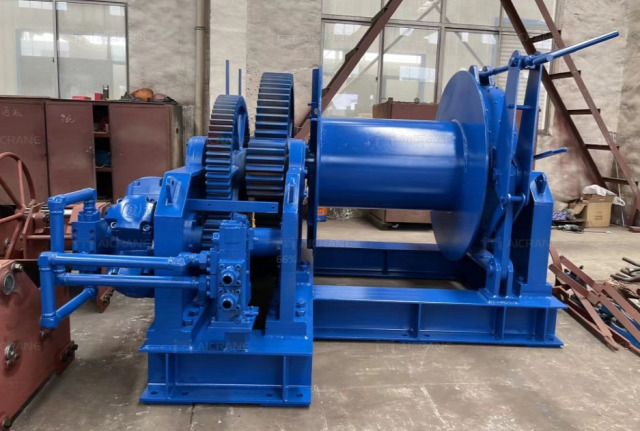Hydraulic tugger winches are vital equipment used in various industries, including marine, offshore, and construction. These powerful winches provide pulling capabilities for a wide range of applications. To gain a deeper understanding of hydraulic tugger winches, it is essential to explore their main components and their functionalities. In this article, we will delve into the key components of a hydraulic tugger winch, shedding light on their roles and contributions to efficient and reliable winching operations.

Drum and Spooling System
The drum is a central component of a hydraulic tugger winch, responsible for winding and storing the wire rope or cable. The drum's design varies depending on the specific application and load requirements. It is typically constructed from high-strength steel and features grooves or flanges to prevent the wire rope from slipping during operation. The spooling system ensures proper winding and alignment of the wire rope on the drum, preventing overlaps or entanglements that could compromise winching performance.
Hydraulic Motor and Pump
The hydraulic motor and pump are the powerhouses of a hydraulic tugger winch, converting hydraulic energy into mechanical force. The hydraulic motor drives the rotation of the winch drum, while the hydraulic pump supplies pressurized hydraulic fluid to the motor. The motor's speed and torque can be controlled using the hydraulic system, allowing for precise and efficient winching operations. The hydraulic motor and pump are typically designed to withstand heavy loads and operate under demanding conditions.
Control System and Valves
The control system and valves are crucial components that govern the operation of a hydraulic tugger winch. They allow operators to control the winch's direction, speed, and braking. The control system may include manual or electronic controls, depending on the winch's complexity and automation level. Various valves, such as directional control valves and flow control valves, regulate the flow and pressure of the hydraulic fluid, enabling smooth and precise winch movements.
Braking System
A reliable braking system is essential for safe and controlled winching operations. The braking system of a hydraulic tugger winch is designed to hold and control the load when the winch is not actively pulling. It ensures that the load does not slip or freefall unexpectedly, protecting personnel and equipment. The braking system may include mechanical brakes, hydraulic brakes, or a combination of both, offering reliable stopping power and load control.
Wire Rope or Cable
The wire rope or cable used with a hydraulic tugger winch is a critical component that directly engages with the load. It must be selected based on the specific application requirements, taking into account factors such as strength, durability, and flexibility. The wire rope is wound around the drum and serves as the primary connection between the winch and the load. Regular inspection and maintenance of the wire rope are essential to ensure safe and efficient winching operations.
Frame and Mounting System
The frame and mounting system provide the structural support and stability for the hydraulic tugger winch. The frame is typically constructed from high-strength steel, designed to withstand the forces generated during winching operations. It ensures proper alignment and secure mounting of the winch components. The mounting system allows for installation on various platforms, such as vessels, trucks, or stationary structures, ensuring versatility and adaptability in different applications.
Conclusion
Hydraulic tugger winches rely on a range of essential components to deliver reliable and efficient pulling capabilities. The drum and spooling system, hydraulic motor and pump, control system and valves, braking system, wire rope or cable, and frame and mounting system work together to ensure smooth and controlled winching operations. Understanding the functions and interactions of these key components is crucial for selecting, operating, and maintaining hydraulic tugger winches effectively, ultimately contributing to successful and safe winching operations in various industries.

